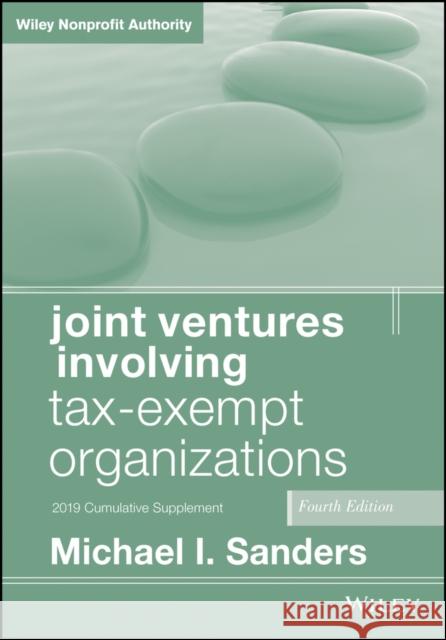Joint Ventures Involving Tax-Exempt Organizations, 2019 Cumulative Supplement » książka



Joint Ventures Involving Tax-Exempt Organizations, 2019 Cumulative Supplement
ISBN-13: 9781119615859 / Angielski / Miękka / 2019 / 256 str.
Joint Ventures Involving Tax-Exempt Organizations, 2019 Cumulative Supplement
ISBN-13: 9781119615859 / Angielski / Miękka / 2019 / 256 str.
(netto: 575,84 VAT: 5%)
Najniższa cena z 30 dni: 599,68
ok. 30 dni roboczych
Bez gwarancji dostawy przed świętami
Darmowa dostawa!
Preface xiAcknowledgments xvChapter 1: Introduction: Joint Ventures Involving Exempt Organizations 1 1.4 University Joint Ventures 1 1.5 Low-Income Housing and New Markets Tax Credit Joint Ventures 1 1.6 Conservation Joint Ventures 2 1.8 Rev. Rul. 98-15 and Joint Venture Structure 2 1.10 Ancillary Joint Ventures: Rev. Rul. 2004-51 2 1.14 The Exempt Organization as a Lender or Ground Lessor 2 1.15 Partnership Taxation 3 1.17 Use of a Subsidiary as a Participant in a Joint Venture 3 1.22 Limitation on Private Foundation's Activities That Limit Excess Business Holdings 4 1.24 Other Developments 4Chapter 2: Taxation of Charitable Organizations 5 2.1 Introduction (Revised) 5 2.2 Categories of Exempt Organizations (Revised) 10 2.3 501(c)(3) Organizations: Statutory Requirements (Revised) 13 2.4 Charitable Organizations: General Requirements 14 2.6 Application for Exemption 15 2.7 Governance 21 2.8 Form 990: Reporting and Disclosure Requirements (Revised) 22 2.10 The IRS Audit 24 2.11 Charitable Contributions (Revised) 27Chapter 3: Taxation of Partnerships and Joint Ventures 35 3.1 Scope of Chapter 35 3.3 Classification as a Partnership 38 3.4 Alternatives to Partnerships 38 3.7 Formation of Partnership 38 3.8 Tax Basis in Partnership Interest 39 3.9 Partnership Operations 39 3.11 Sale or Other Disposition of Assets or Interests 40 3.12 Other Tax Issues (Revised) 41Chapter 4: Overview: Joint Ventures Involving Exempt Organizations 47 4.1 Introduction 47 4.2 Exempt Organization as General Partner: A Historical Perspective 48 4.6 Revenue Ruling 2004-51 and Ancillary Joint Ventures 50 4.9 Conversions from Exempt to For-Profit and from For-Profit to Exempt Entities 50 4.10 Analysis of a Virtual Joint Venture 50Chapter 5: Private Benefit, Private Inurement, and Excess Benefit Transactions 53 5.1 What Are Private Inurement and Private Benefit? (Revised) 53 5.2 Transactions in Which Private Benefit or Inurement May Occur 55 5.3 Profit-Making Activities as Indicia of Nonexempt Purpose 57 5.4 Intermediate Sanctions (Revised) 57 5.7 State Activity with Respect to Insider Transactions 65Chapter 6: Engaging in a Joint Venture: The Choices 67 6.1 Introduction 67 6.2 LLCs (Revised) 68 6.3 Use of a For-Profit Subsidiary as Participant in a Joint Venture 69 6.5 Private Foundations and Program-Related Investments 73 6.6 Nonprofits and Bonds (Revised) 77 6.7 Exploring Alternative Structures 79 6.8 Other Approaches 80Chapter 7: Exempt Organizations as Accommodating Parties in Tax Shelter Transactions 83 7.2 Prevention of Abusive Tax Shelters 83 7.3 Excise Taxes and Penalties 84Chapter 8: The Unrelated Business Income Tax 85 8.1 Introduction 85 8.3 General Rule 86 8.4 Statutory Exceptions to UBIT (Revised) 87 8.5 Modifications to UBIT (Revised) 87 8.7 Calculation of UBIT (Revised) 88Chapter 9: Debt-Financed Income 99 9.1 Introduction 99 9.2 Debt-Financed Property 99 9.6 The Final Regulations 100Chapter 10: Limitation on Excess Business Holdings 103 10.1 Introduction 103 10.2 Excess Business Holdings: General Rules (Revised) 103 10.3 Tax Imposed 105 10.4 Exclusions 105Chapter 12: Healthcare Entities in Joint Ventures 109 12.1 Overview 109 12.2 Classifications of Joint Ventures 110 12.3 Tax Analysis 110 12.4 Other Healthcare Industry Issues 113 12.5 Preserving the 50/50 Joint Venture 113 12.9 Government Scrutiny 114 12.11 The Patient Protection and Affordable Care Act of 2010: 501(r) and Other Statutory Changes Impacting Nonprofit Hospitals 114 12.12 The Patient Protection and Affordable Care Act of 2010: ACOs and Co-Ops: New Joint Venture Healthcare Entities 117Chapter 13: Low-Income Housing, New Markets, Rehabilitation, and Other Tax Credit Programs 119 13.2 Nonprofit-Sponsored LIHTC Project (New) 119 13.3 Low-Income Housing Tax Credit (Revised) 120 13.4 Historic Investment Tax Credit 122 13.6 New Markets Tax Credits (Revised) 126 13.10 The Energy Tax Credits 141 13.11 The Opportunity Zone Funds: New Section 1400Z-1 and Section 1400Z-2 (Revised) 142Appendix 13B (New) 165Chapter 14: Joint Ventures with Universities 183 14.1 Introduction 183 14.3 Colleges and Universities IRS Compliance Initiative (New) 188 14.5 Faculty Participation in Research Joint Ventures 189 14.6 Nonresearch Joint Venture Arrangements 189 14.7 Modes of Participation by Universities in Joint Ventures (Revised) 189Chapter 15: Business Leagues Engaged in Joint Ventures 193 15.1 Overview 193 15.2 The Five-Prong Test 194 15.3 Unrelated Business Income Tax 194Chapter 16: Conservation Organizations in Joint Ventures 195 16.1 Overview 195 16.2 Conservation and Environmental Protection as a Charitable or Educational Purpose: Public and Private Benefit 195 16.3 Conservation Gifts and 170(h) Contributions (Revised) 196 16.7 Emerging Issues 210Chapter 17: International Joint Ventures 211 17.5 General Grantmaking Rules 211 17.11 Application of Foreign Tax Treaties 212Chapter 19: Debt Restructuring and Asset Protection Issues 215 19.1 Introduction 215 19.2 Overview of Bankruptcy 215 19.3 The Estate and the Automatic Stay 216 19.4 Case Administration 217 19.5 Chapter 11 Plan 217 19.6 Discharge 218Index 219
MICHAEL I. SANDERS (Washington DC) is the lead partner of Blank Rome's Washington office's tax group with a large practice in the area of exempt organizations involving healthcare and low-income housing, associations and joint ventures between for-profits and nonprofits, as well as structuring New Markets Tax Credit transactions. Sanders is also an adjunct professor at George Washington University Law Center and Georgetown University Law School teaching Income Taxation of Partnerships and Subchapter S Corporations and Tax Treatment of Charities and Other Non-Profit Organizations, Joint Ventures Involving Tax Exempt Organizations (including healthcare, universities, LIHTC, new markets, conservation organizations, respectively. Previously, Mr. Sanders served as an attorney-advisor to the assistant secretary of tax policy at the Office of Tax Legislative Counsel and as a trial attorney at the U.S. Department of Justice (Attorney General's Honors Program). He was recently honored in 2010 by The George Washington University School of Law for his 35 years of teaching at the law school.
1997-2025 DolnySlask.com Agencja Internetowa
KrainaKsiazek.PL - Księgarnia Internetowa









